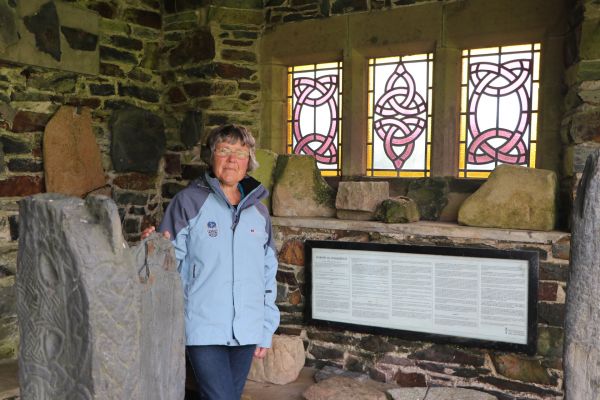In our regular feature in Business 365 magazine, published by Mannin Media, authors from different walks of Manx life offer a personal perspective on #MyBiosphere. This month, Marinda Fargher writes:
A Manx woman with family across, some in Northumberland, one of my outstanding recent memories is of a visit we made to Lindisfarne. It is an important centre of early Christianity and is known as Holy Island.
The reason I remember my visit, apart from my anxious feelings caused by its tidal access, is because it took this visit to remind me, in a revelation-type moment, to realise that I lived on a holy island.
I know it because I am blessed to live in the Parish of Maughold, with its early Christian/Medieval monastic site based around the present Parish Church and burial ground.
We have an outstanding collection of Manx crosses, displayed in a crosshouse and hidden among more recent burials the remains of medieval buildings we call keeills.
This place is of special historic interest. If you study the carved stones you will find that they are comparable with those found at Iona, Whithorn and other places you may have heard of.
I believe that they are of huge value and importance, dating probably from the formation of the Monastery in the 7th Century. They themselves are historical sources as well as art treasures, telling the story of this place in history...a story which is not found in written records, a story yet to be fully told.

On these stones you will find personal names, different languages and evocative decorations and symbols. They illustrate aspects of our history from the founders of monasticism, St Paul and St Antony, to heroes of the Norse Sagas, Sigurd and Loki.
They may inspire you to wonder ‘who were those named Irneit, Guriat, Branhui’....and a Norse woman, Hlif, who has a Viking ship carved on her memorial.
What brought them to Maughold, to our Island.
Most of the crosses were found around the churchyard and its environs, but you may want to think about the connection between this place and those keeills that are scattered around the Parish, like the one high in the Corony Valley where in the 12th century John, the Priest here, carved his own message for his flock.
Maughold, this ancient site, is not just about what you see, and can discover, but what you may feel when you visit. Its spirituality is tangible. Services in a keeill here on a beautiful summer’s evening are unforgettable, but come any time and experience the peace of this place, listening only to the bleating of sheep and the calling of choughs.
If you walk towards the headland, you can follow the track down to St Maughold's Well, where visitors, like pilgrims of old, came for healing, carved their name, and left an offering.
Here, again, you may rest, and listen to the birds nesting on the cliffs below...shag, kittiwake, guillemots. Look out for dolphins. Enjoy your picnic...and refresh your spirit.
As I write this, Manx National Heritage and the Church are considering the future of the crosses at Maughold...their protection and promotion.
Local people are supportive. Now may be the right time to give Maughold the recognition it deserves to safeguard its past and its future.
Marinda Fargher is a Blue Badge Guide who lives in and loves the Parish of Maughold, its history and natural beauty. She is on the Praying the Keeills committee and is a member of the local authority.


